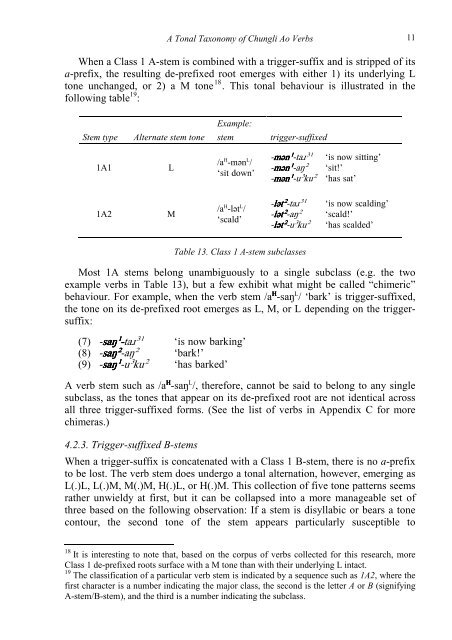A TONAL TAXONOMY OF CHUNGLI AO VERBS Daniel Bruhn ...
A TONAL TAXONOMY OF CHUNGLI AO VERBS Daniel Bruhn ...
A TONAL TAXONOMY OF CHUNGLI AO VERBS Daniel Bruhn ...
Create successful ePaper yourself
Turn your PDF publications into a flip-book with our unique Google optimized e-Paper software.
A Tonal Taxonomy of Chungli Ao Verbs<br />
When a Class 1 A-stem is combined with a trigger-suffix and is stripped of its<br />
a-prefix, the resulting de-prefixed root emerges with either 1) its underlying L<br />
tone unchanged, or 2) a M tone 18 . This tonal behaviour is illustrated in the<br />
following table 19 :<br />
Example:<br />
Stem type Alternate stem tone stem trigger-suffixed<br />
1A1 L<br />
1A2 M<br />
/a H -mən L /<br />
‘sit down’<br />
/a H -lət L /<br />
‘scald’<br />
Table 13. Class 1 A-stem subclasses<br />
-mmmməəəən¹ n¹-taɹ³¹ n¹ n¹ ‘is now sitting’<br />
-mmmməəəən¹ n¹-aŋ² n¹ n¹ ‘sit!’<br />
-mmmməəəən¹ n¹-u³ku² n¹ n¹ ‘has sat’<br />
-lllləəəət² t²-taɹ³¹ t² t² ‘is now scalding’<br />
-lllləəəət² t²-aŋ² t² t² ‘scald!’<br />
-lllləəəət² t²-u³ku² t² t² ‘has scalded’<br />
Most 1A stems belong unambiguously to a single subclass (e.g. the two<br />
example verbs in Table 13), but a few exhibit what might be called “chimeric”<br />
behaviour. For example, when the verb stem /a H -saŋ L / ‘bark’ is trigger-suffixed,<br />
the tone on its de-prefixed root emerges as L, M, or L depending on the triggersuffix:<br />
(7) -sa saŋŋŋŋ¹¹¹¹----taɹ³¹ sa sa<br />
‘is now barking’<br />
(8) -sa saŋŋŋŋ²²²²-aŋ² sa sa<br />
‘bark!’<br />
(9) -sa saŋŋŋŋ¹¹¹¹-u³ku² sa sa<br />
‘has barked’<br />
A verb stem such as /a H -saŋ L /, therefore, cannot be said to belong to any single<br />
subclass, as the tones that appear on its de-prefixed root are not identical across<br />
all three trigger-suffixed forms. (See the list of verbs in Appendix C for more<br />
chimeras.)<br />
4.2.3. Trigger-suffixed B-stems<br />
When a trigger-suffix is concatenated with a Class 1 B-stem, there is no a-prefix<br />
to be lost. The verb stem does undergo a tonal alternation, however, emerging as<br />
L(.)L, L(.)M, M(.)M, H(.)L, or H(.)M. This collection of five tone patterns seems<br />
rather unwieldy at first, but it can be collapsed into a more manageable set of<br />
three based on the following observation: If a stem is disyllabic or bears a tone<br />
contour, the second tone of the stem appears particularly susceptible to<br />
18 It is interesting to note that, based on the corpus of verbs collected for this research, more<br />
Class 1 de-prefixed roots surface with a M tone than with their underlying L intact.<br />
19 The classification of a particular verb stem is indicated by a sequence such as 1A2, where the<br />
first character is a number indicating the major class, the second is the letter A or B (signifying<br />
A-stem/B-stem), and the third is a number indicating the subclass.<br />
11

















